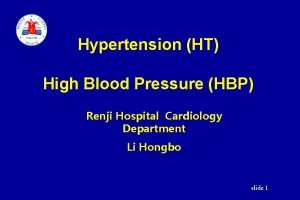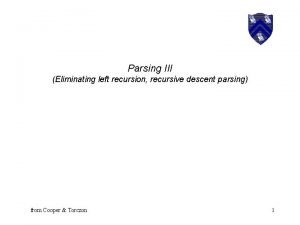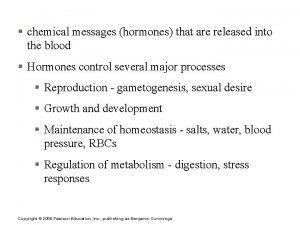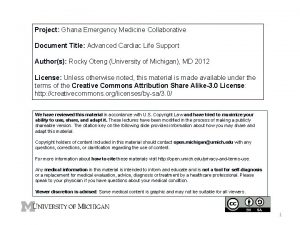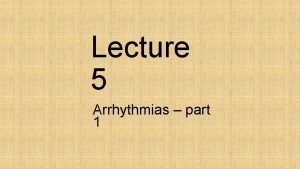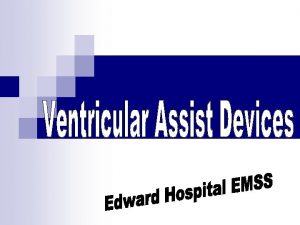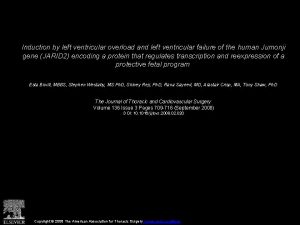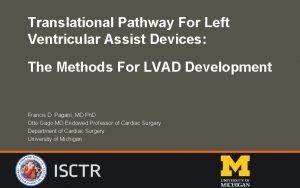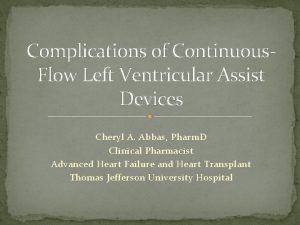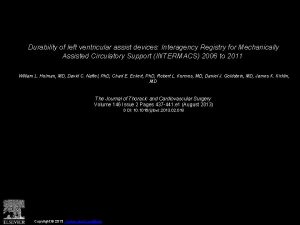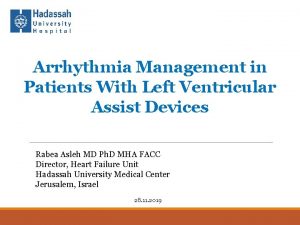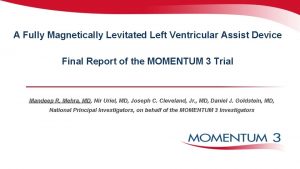Left Ventricular Assist Devices The What and the


















- Slides: 18

Left Ventricular Assist Devices: The What and the Who Lance E. Sullenberger MD FACC FACP Capital Cardiology Associates

But US Heart Failure Transplants Increasing… Stable

Left Ventricular Assist Device Pulsatile Flow • Not a true artificial heart. • Assists the left ventricle in passing oxygenated blood through the body. • Initially was a pulsatile device (similar to native heart…)

Left Ventricular Assist Device Continuous (Axial) Flow

Pulsatile Flow is Out Axial Flow is In

The Down Side • • • Infection Bleeding Thrombosis Embolism Battery issues Hemolysis

Who Gets an LVAD? • Bridge to Recovery • Bridge to Transplant • Destination Therapy

Bridge to Recovery • Acute Myocarditis • Acute Myocardial Infarction • Peripartum Cardiomyopathy • Younger • Previously healthy • Few comorbidities

Bridge to Transplant

Destination Therapy REMATCH Trial • • Can’t a TX 129 get patients – Older • Ineligible for cardiac – Hepatitis transplant – DM with small vessel • Class IV CHF disease ½ received • • Might not get. LVAD a TX issues medical • –½Renal received –therapy PHTN alone • Complex surgical

Warning Signs!!


Inability to Take CHF Therapy

Low Sodium

Cardiorenal Syndrome

Warning Signs! Recurrent Admissions Low Blood Pressure Hyponatremia Poor Renal Function Use of Continuous Inotropes • Increasing diuretic dose • Worsening Heart Failure Class • • •

Bring It Home….

Thank You!!! LANCE SULLENBERGER MD LSULLENBERGER@CAPITALCARDIOLOGY. COM
 Left ventricular hypertrophy
Left ventricular hypertrophy Morphology of hypertension
Morphology of hypertension Turn left turn right go straight on
Turn left turn right go straight on The left recursion produces
The left recursion produces One teach, one assist pros and cons
One teach, one assist pros and cons Hormonal stimulus
Hormonal stimulus Left left right right go turn around go go go
Left left right right go turn around go go go Stage left and right
Stage left and right Left on left sacral torsion
Left on left sacral torsion Left left right right go go go
Left left right right go go go You put your right foot in
You put your right foot in Drenaj ventricular extern
Drenaj ventricular extern H's and t's
H's and t's Capture beat
Capture beat Capture beat
Capture beat Bigeminism ventricular tratament
Bigeminism ventricular tratament Ventricular escape rhythm
Ventricular escape rhythm Acetazolamide dose in hydrocephalus
Acetazolamide dose in hydrocephalus Espironola
Espironola

